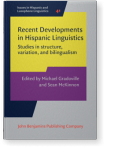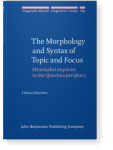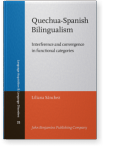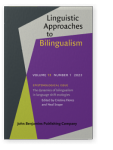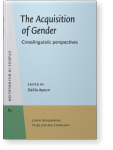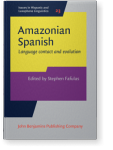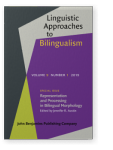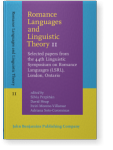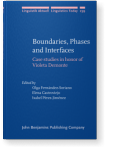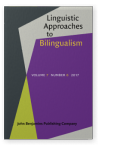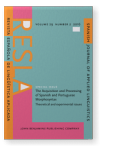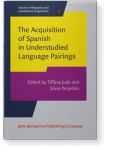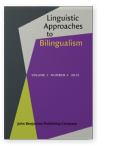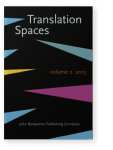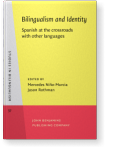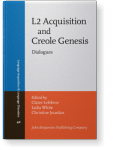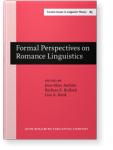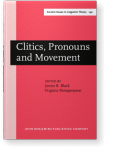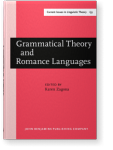Liliana Sánchez
List of John Benjamins publications for which Liliana Sánchez plays a role.
Book series
Titles
The Morphology and Syntax of Topic and Focus: Minimalist inquiries in the Quechua periphery
Liliana Sánchez
[Linguistik Aktuell/Linguistics Today, 169] 2010. xiii, 242 pp.
Subjects Generative linguistics | Languages of South America | Morphology | Syntax | Theoretical linguistics
Romance Linguistics 2006: Selected papers from the 36th Linguistic Symposium on Romance Languages (LSRL), New Brunswick, March-April 2006
Edited by José Camacho, Nydia Flores-Ferrán, Liliana Sánchez, Viviane Déprez and María José Cabrera
[Current Issues in Linguistic Theory, 287] 2007. viii, 340 pp.
Subjects Romance linguistics | Theoretical linguistics
Quechua-Spanish Bilingualism: Interference and convergence in functional categories
Liliana Sánchez
[Language Acquisition and Language Disorders, 35] 2003. x, 189 pp.
Subjects Generative linguistics | Languages of South America | Multilingualism | Romance linguistics
2023 Carefully considering the need, precision, and usefulness of classifying bilingual speakers in language shift contexts Epistemological issue: The dynamics of bilingualism in language shift ecologies, Flores, Cristina and Neal Snape (eds.), pp. 45–50 | Commentary
2022 Chapter 4. The acquisition of grammatical gender in child and adult heritage speakers of Spanish: Beyond the source of differences The Acquisition of Gender: Crosslinguistic perspectives, Ayoun, Dalila (ed.), pp. 71–94 | Chapter
Previous work on the acquisition of grammatical gender in child and adult heritage speakers of Spanish has found significant mismatches in gender agreement stemming from overgeneralization of the masculine form to contexts in which the feminine is required. It has been argued that these… read more
2020 Chapter 7. Animacy hierarchy effects on L2 processing of Differential Object Marking The Acquisition of Differential Object Marking, Mardale, Alexandru and Silvina Montrul (eds.), pp. 183–206 | Chapter
Studies on L2 processing of Differential Object Marking (DOM) are scant and mostly focus on the animacy of the object. We investigated the interaction of three understudied factors in L1 and L2 processing of DOM: type of animacy (human vs. non-human animal), gender and number of the object… read more
2020 Chapter 6. Clitics and argument marking in Shipibo-Spanish and Ashéninka-Perené-Spanish bilingual speech Amazonian Spanish: Language Contact and Evolution, Fafulas, Stephen (ed.), pp. 127–154 | Chapter
Direct object clitics in Spanish are morphological markers at the interface of syntax and phonology, morphology, semantics and information structure. We explore variability in direct object clitic doubling and argument marking in bilingual speakers of Shipibo-Spanish and Ashéninka-Perené-Spanish… read more
2019 Processing DOM in relative clauses: Salience and optionality in early and late bilinguals Representation and Processing in Bilingual Morphology, Austin, Jennifer R. (ed.), pp. 120–160 | Article
Early heritage bilinguals have been repeatedly found to differ from late bilinguals and from monolinguals (e.g., Montrul, 2008, 2011). In the realm of Spanish Differential Object Marking (DOM), both early heritage bilinguals (Montrul et al., 2015) and late bilinguals (e.g., Bowles & Montrul,… read more
2017 Chapter 10. Null subjects in the early acquisition of English by child heritage speakers of Spanish Romance Languages and Linguistic Theory 11: Selected papers from the 44th Linguistic Symposium on Romance Languages (LSRL), London, Ontario, Perpiñán, Silvia, David Heap, Itziri Moreno-Villamar and Adriana Soto-Corominas (eds.), pp. 209–227 | Chapter
This paper investigates the development of English and Spanish subject production in 8 heritage bilingual children (age range: 4;1–5;3; mean age: 4;7). Oral production of overt and null subjects was assessed using a picture-based story re-telling task and a description task. Subjects were coded… read more
2017 Does the verb raise to T in Spanish? Boundaries, Phases and Interfaces: Case studies in honor of Violeta Demonte, Fernández-Soriano, Olga, Elena Castroviejo Miró and Isabel Pérez-Jiménez (eds.), pp. 47–62 | Chapter
We test adverb-verb word orders in Peruvian Spanish against analyses of verb movement (Pollock 1989, Embick & Noyer 2001). While the preferred order is V-adv-O, the alternative Adv-V-O is also possible. We propose that the verb raises in overt syntax and morphological insertion targets either the… read more
2017 The influence of conversational context and the developing lexicon on the calculation of scalar implicatures: Insights from Spanish-English bilingual children Linguistic Approaches to Bilingualism 7:2, pp. 230–264 | Article
Although monolingual children do not generally calculate the upper-bounded scalar implicature (SI) associated with ‘some’ without additional support, monolingual Spanish-speaking children have been reported to do so with algunos (‘some’), and further distinguish algunos from unos. Given… read more
2016 Object agreement marking and information structure along the Quechua-Spanish contact continuum The Acquisition and Processing of Spanish and Portuguese Morphosyntax: Theoretical and experimental issues, Klassen, Rachel, Anahí Alba de la Fuente, Joanne Markle LaMontagne and Almudena Basanta y Romero-Valdespino (eds.), pp. 544–581 | Article
Direct object clitics in Spanish are morphological markers at the interfaces of syntax, phonology, morphology, and information structure (Zwicky, 1985; Ordóñez & Repetti, 2006; Belloro, 2007; Spencer & Luís, 2012). They play an important part in argument morphology in Spanish and are subject to… read more
2015 Crosslinguistic influences in the mapping of functional features in Quechua-Spanish Bilingualism The Acquisition of Spanish in Understudied Language Pairings, Judy, Tiffany and Silvia Perpiñán (eds.), pp. 21–48 | Article
This paper discusses evidence of crosslinguistic influence that involves the emergence of new patterns of feature-morphology mapping in Spanish as spoken by native speakers of Quechua. It builds on the notions of functional interference and functional convergence (Sánchez 2003, 2004) and of feature… read more
2013
Modeling the competence grammar of heritage speakers who exhibit low proficiency in their L1 represents a significant challenge for generative and experimental approaches to bilingual linguistic research. In this paper we revisit the core tenets of the incomplete acquisition hypothesis as… read more
2013 Found in translation: Computational discovery of translation effects Translation Spaces 2, pp. 81–104 | Article
We describe translation effects that have been studied in the automated text classification literature. We expand on a point within this research space, quality effects, with our own work in this area. We present an efficient method for evaluating text quality on the basis of reference texts. The… read more
2008 5. Literacy and the expression of social identity in a dominant language: A description of "mi familia" by Quechua-Spanish bilingual children Bilingualism and Identity: Spanish at the crossroads with other languages, Niño-Murcia, Mercedes and Jason Rothman (eds.), pp. 109–126 | Article
2006 Bilingual grammars and Creoles: Similarities between functional convergence and morphological elaboration L2 Acquisition and Creole Genesis: Dialogues, Lefebvre, Claire, Lydia White and Christine Jourdan (eds.), pp. 277–294 | Article
2001 Discourse Topic Constraints on Left Dislocated Subjects and CLLD Structures Features and Interfaces in Romance: Essays in honor of Heles Contreras, Herschensohn, Julia, Enrique Mallén and Karen Zagona (eds.), pp. 255–266 | Article
1999 Null Objects and D0 Features in Contact Spanish Formal Perspectives on Romance Linguistics: Selected papers from the 28th Linguistic Symposium on Romance Languages (LSRL XXVIII), University Park, 16–19 April 1998, Authier, Jean-Marc, Barbara E. Bullock and Lisa A. Reed (eds.), pp. 227–242 | Article
1997 The genitive clitic and the genitive construction in Andean Spanish Clitics, Pronouns and Movement, Black, James R. and Virginia Motapanyane (eds.), pp. 23–38 | Article
1996 Word order, predication and agreement in DPs in Spanish, Southern Quechua and southern andean bilingual Spanish Grammatical Theory and Romance Languages: Selected papers from the 25th Linguistic Symposium on Romance Languages (LSRL XXV) Seattle, 2–4 March 1995, Zagona, Karen (ed.), pp. 209–218 | Article
